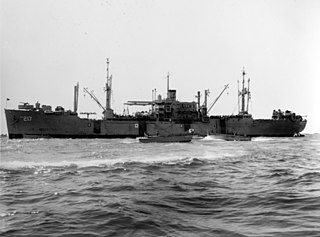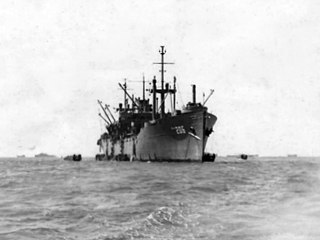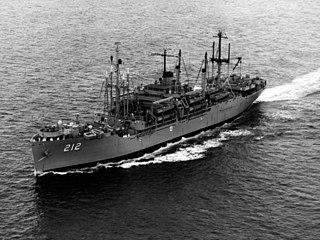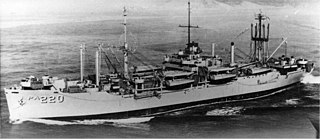Service history
World War II
Following commissioning and fitting out, Okaloosa departed Seattle with troops 26 January 1945, for Honolulu, then operated out of Pearl Harbor until sailing 29 March, with US Army units for Eniwetok, Ulithi, and Okinawa. She arrived off Okinawa 26 April, and offloaded troops without incident during the next four days, despite frequent enemy air attacks. The transport then returned to the West Coast, arriving San Francisco 22 May. Her stay was short, however, and she embarked troops and cargo immediately, leaving 30 May, for Manila and Leyte, Philippines. Except for a brief voyage to New Guinea in early July, Okaloosa shuttled troops and cargo among the Philippine Islands until departing Manila Bay 7 September, for Tokyo Bay with occupation units.
Post-war service
From Tokyo Bay, Okaloosa sailed, in turn, to Guam; Qingdao, China; Manila; and Haiphong, French Indo-China; where she loaded elements of the Chinese 52nd Army bound for the Gulf of Bohai, China.
Operation Magic Carpet
Assigned to Operation Magic Carpet on 16 November, Okaloosa sailed to Jinsen, Korea, took on her full capacity of returning troops, and sailed 30 November, for Tacoma, Washington, arriving 17 December. Four days later, she entered Puget Sound Navy Yard for overhaul. She sailed 11 January 1946, via the Panama Canal for Norfolk, Virginia, arriving on the last day of the month. Also, on 14 January, she came under full ownership of the Navy.
Peacetime cruises
For the next few years, Okaloosa operated out of Norfolk, many times with Marines from nearby bases. Three times, in June and July 1947, and June 1948, she conducted cruises for large numbers of east coast reservists, sailing to Bermuda on the last two. In addition, amphibious exercises took her to Puerto Rico and other Caribbean islands on a number of month-long cruises and several shorter ones.
Decommissioning and fate
On 15 April 1949, Okaloosa sailed from Norfolk for Orange, Texas, and deactivation. After overhaul, she decommissioned on 21 July, and entered the Texas Group, Atlantic Reserve Fleet. She was returned to the Maritime Administration (MARAD) 23 September 1955, with permanent custody transferred 26 September 1958. She was struck from the Navy Register 1 October 1958. On 28 October 1971, Okaloosa was sold to Union Minerals & Alloys Corporation, along with eight other ships, for $467,100, with the condition that they would be scrapped. At the time she was part of the National Defense Reserve Fleet, Mobile, Alabama, Group. On 30 May 1972, she was officially withdrawn from the Reserve Fleet.
Ship's bell
When the vessel was dismantled, its relics were salvaged and Baldwin County, Alabama requested the ship's bell for a war memorial at its satellite courthouse in Foley. Okaloosa County Judge T. Patterson Maney, a retired U.S. Army brigadier general, discovered the bell during a visit to Foley and worked to bring it back to its namesake county. On 4 January 2012, county officials of Okaloosa County, Florida, retrieved the bell from Foley for display in front of the Destin–Fort Walton Beach Airport. In exchange, the U.S. Navy presented Baldwin County with the bell from Peterson for its memorial. Okaloosa County held a dedication on 26 April 2012.
"The Baldwin County Commission has been extremely gracious," said Tracy Stage, projects manager for the airport, of the transfer of the bell. "We're bringing it back to Okaloosa County where it belongs. I can't think of a better way to recognize the Navy, the Marine Corps and all the veterans."

USS Talladega (APA/LPA-208) was a Haskell-class attack transport of the US Navy. She was of the VC2-S-AP5 Victory ship design type. Talladega was named for Talladega County, Alabama.

USS Pitt (APA-223/LPA-223) was a Haskell-class attack transport in service with the United States Navy from 1944 to 1947. She was scrapped in 1980.

USS Sherburne (APA-205) was a US Navy Haskell-class attack transport, built and used during World War II. She was of the VC2-S-AP5 Victory ship design type. Sherburne was named for Sherburne County, Minnesota. She was later converted and renamed USS Range Sentinel (AGM-22), a missile range instrumentation ship.

USS Mifflin (APA-207) was a Haskell-class attack transport in service with the United States Navy from 1944 to 1946. She was scrapped in 1975.

USS Clinton (APA/LPA-144) was a Haskell-class attack transport in service with the United States Navy from 1945 to 1946. She was sunk as a target in 1984.

USS Pickaway (APA/LPA-222) was a Haskell-class attack transport that saw service with the US Navy in World War II, the Korean War and the Vietnam War. She was of the VC2-S-AP5 Victory ship design type and named after Pickaway County, Ohio.

USS Randall (APA-224) was a Haskell-class attack transport in service with the United States Navy from 1944 to 1956. She was sold for scrap in 1972.

USS New Kent (APA-217) was a Haskell-class attack transport in service with the United States Navy from 1944 to 1949 and from 1951 to 1954. She was scrapped in 1972.

USS Olmsted (APA-188) was a Haskell-class attack transport that saw service with the US Navy for the task of transporting troops to and from combat areas. She was of the VC2-S-AP5 Victory ship design type. Olmsted was named for Olmsted County, Minnesota.

USS Sarasota (APA/LPA-204) was a Haskell-class attack transport that saw service with the US Navy in World War II, Korean War Era and after. She was of the VC2-S-AP5 Victory ship design type. Sarasota was named for Sarasota County, Florida.

USS Sibley (APA-206) was a Haskell-class attack transport in service with the United States Navy from 1944 to 1946. She was scrapped in 1975.

USS Tazewell (APA/LPA-209) was a Haskell-class attack transport in service with the United States Navy from 1944 to 1946. She was scrapped in 1973.

USS Telfair (APA/LPA-210) was a Haskell-class attack transport that saw service with the US Navy in World War II and the Korean War. She remained in service through most of the 1950s and 1960s, where she participated in various peacetime operations. Telfair was named for Telfair County, Georgia, which was itself named after Edward Telfair, the second Governor of the state, a member of the Continental Congress, and a signer of the Articles of Confederation.

USS Montrose (APA/LPA-212) was a Haskell-class attack transport in service with the United States Navy from 1944 to 1946 and from 1950 to 1969. She was scrapped in 1970.

USS Mountrail (APA/LPA-213) was a Haskell-class attack transport of the US Navy in World War II, the Korean War and Vietnam War era. She was of the VC2-S-AP5 Victory ship design type. Mountrail was named for Mountrail County, North Dakota.

USS Natrona (APA-214) was a Haskell-class attack transport of the US Navy in World War II. She was of the VC2-S-AP5 Victory ship design type. Natrona was named for Natrona County, Wyoming.

USS Oneida (APA-221) was a Haskell-class attack transport in service with the United States Navy from 1944 to 1946. She was scrapped in 1975.

USS Navarro (APA/LPA-215) was a Haskell-class attack transport of the US Navy. She was of the VC2-S-AP5 Victory ship design type that saw service in World War II and the Vietnam War. Navarro was named after Navarro County, Texas.

USS Okanogan (APA/LPA-220) was a Haskell-class attack transport that saw service with the US Navy in World War II, the Korean War and the Vietnam War. She was of the VC2-S-AP5 Victory ship design type and named after Okanogan County, Washington.

USS Rockwall (APA-230) was a Haskell-class attack transport that served in the United States Navy from 1945 to 1947 and from 1951 to 1955. She was scrapped in 1984.
This page is based on this
Wikipedia article Text is available under the
CC BY-SA 4.0 license; additional terms may apply.
Images, videos and audio are available under their respective licenses.




















